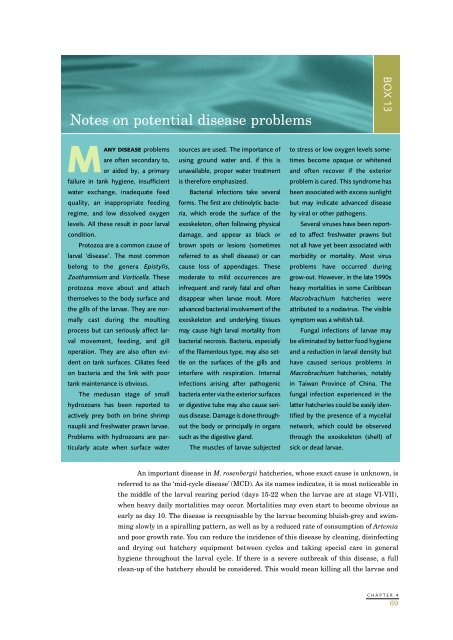You also want an ePaper? Increase the reach of your titles
YUMPU automatically turns print PDFs into web optimized ePapers that Google loves.
Notes on potential disease problemsBOX 13MANY DISEASE problemsare often secondary to,or aided by, a primaryfailure in tank hygiene, insufficientwater exchange, inadequate feedquality, an inappropriate feedingregime, and low dissolved oxygenlevels. All these result in poor larvalcondition.Protozoa are a common cause oflarval ‘disease’. The most commonbelong to the genera Epistylis,Zoothamnium and Vorticella. Theseprotozoa move about and attachthemselves to the body surface andthe gills of the larvae. They are normallycast during the moultingprocess but can seriously affect larvalmovement, feeding, and gilloperation. They are also often evidenton tank surfaces. Ciliates feedon bacteria and the link with poortank maintenance is obvious.The medusan stage of smallhydrozoans has been reported toactively prey both on brine shrimpnauplii and <strong>freshwater</strong> prawn larvae.Problems with hydrozoans are particularlyacute when surface watersources are used. The importance ofusing ground water and, if this isunavailable, proper water treatmentis therefore emphasized.Bacterial infections take severalforms. The first are chitinolytic bacteria,which erode the surface of theexoskeleton, often following physicaldamage, and appear as black orbrown spots or lesions (sometimesreferred to as shell disease) or cancause loss of appendages. Thesemoderate to mild occurrences areinfrequent and rarely fatal and oftendisappear when larvae moult. Moreadvanced bacterial involvement of theexoskeleton and underlying tissuesmay cause high larval mortality frombacterial necrosis. Bacteria, especiallyof the filamentous type, may also settleon the surfaces of the gills andinterfere with respiration. Internalinfections arising after pathogenicbacteria enter via the exterior surfacesor digestive tube may also cause seriousdisease. Damage is done throughoutthe body or principally in organssuch as the digestive gland.The muscles of larvae subjectedto stress or low oxygen levels sometimesbecome opaque or whitenedand often recover if the exteriorproblem is cured. This syndrome hasbeen associated with excess sunlightbut may indicate advanced diseaseby viral or other pathogens.Several viruses have been reportedto affect <strong>freshwater</strong> <strong>prawns</strong> butnot all have yet been associated withmorbidity or mortality. Most virusproblems have occurred duringgrow-out. However, in the late 1990sheavy mortalities in some CaribbeanMacrobrachium hatcheries wereattributed to a nodavirus. The visiblesymptom was a whitish tail.Fungal infections of larvae maybe eliminated by better food hygieneand a reduction in larval density buthave caused serious problems inMacrobrachium hatcheries, notablyin Taiwan Province of China. Thefungal infection experienced in thelatter hatcheries could be easily identifiedby the presence of a mycelialnetwork, which could be observedthrough the exoskeleton (shell) ofsick or dead larvae.An important disease in M. rosenbergii hatcheries, whose exact cause is unknown, isreferred to as the ‘mid-cycle disease’ (MCD). As its names indicates, it is most noticeable inthe middle of the larval rearing period (days 15-22 when the larvae are at stage VI-VII),when heavy daily mortalities may occur. Mortalities may even start to become obvious asearly as day 10. The disease is recognisable by the larvae becoming bluish-grey and swimmingslowly in a spiralling pattern, as well as by a reduced rate of consumption of Artemiaand poor growth rate. You can reduce the incidence of this disease by cleaning, disinfectingand drying out hatchery equipment between cycles and taking special care in generalhygiene throughout the larval cycle. If there is a severe outbreak of this disease, a fullclean-up of the hatchery should be considered. This would mean killing all the larvae andCHAPTER 469
















